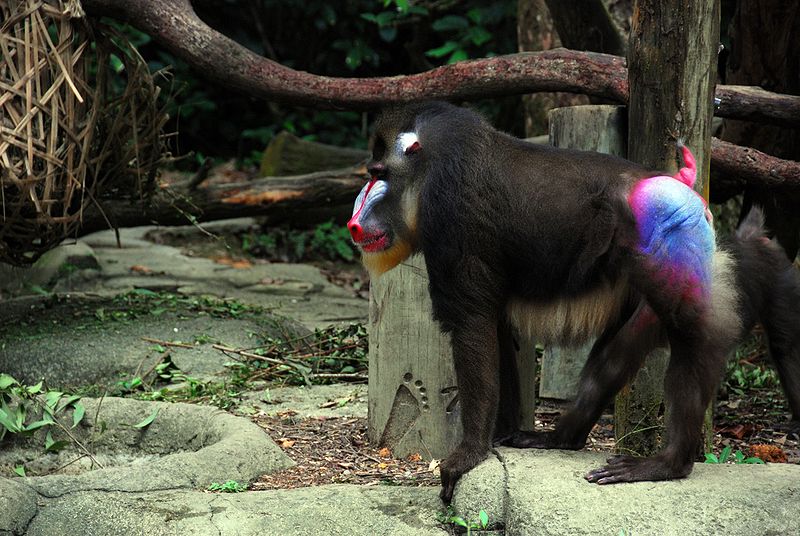

If you’re anything like me, you may have wondered why some monkeys have bright blue skin. Even if you don’t pay careful attention to monkey butts, you may still have wondered what makes some people’s eyes blue.
To answer these questions, it is important to first understand how light interacts with living stuff, which we call biological tissue. Light is a collection of little packets of energy, called photons, that whiz through the air. Photons come in all different colors, and when these colors are all together, we see white light (like sunlight or light from a light bulb). But photons of different colors act differently when they enter biological tissue.
You can think of a photon as a drunk person walking through a forest. The drunk person enters the forest and walks into a tree, D’oh!, changes direction (scatters) and walks another short distance and into another tree, D’oh! D’oh! D’oh! D’oh! …. and before you know it the drunk person exits the forest in a random place going a random direction.
When photons enter the skin, it is just like the drunk person walking in the forest. Photons bounce off collagen fibers (instead of trees) and emerge from the skin at a random place. In optics, we call this diffuse reflection. A visual representation of diffuse reflection is when a LASER beam hits the surface of milk, giving off a “glow ball” around the LASER spot. (You can also catch my personal demonstration HERE).

Before it gets detected by your eye, a single photon that penetrates a biological tissue (like skin) will randomly scatter within the tissue many times. But it is important to consider that skin is more complex than the forest analogy. Skin is composed of many layers and contains pigments such as melanin, and this affects how photons scatter. This added complexity is the secret to the blue monkey butt.
To understand how photons move through a complex tissue like skin, lets compare a red photon with a blue photon as it hits two tissue layers. Tissue “A” is on top, and Tissue “B” is underneath. If layers A and B were both white (like milk), they would reflect red and blue photons equally and you would see both colors.
But in real skin, the top layer (Tissue A) has only a little melanin, while the next layer of skin (Tissue B) can contain a lot of melanin, which is important because melanin absorbs light, “killing” any photons that encounter it!

In the picture above, both the red and blue photons bounce (scatter) 4 times while they are penetrating the skin. But because the red photons travel a longer distance in between scattering events, they manage to penetrate both layers of skin. The melanin in Tissue B absorbs the red photon so it can’t leave the skin and reach your eye.
In contrast, the blue photons take very short steps in between their scattering events, and they don’t penetrate very deep. They do not make it past Tissue A before they emerge and hit your eye.
A baboon’s butt tissue is arranged somewhat like the illustration above so that blue photons are reflected and all of the other photons (like the red ones) are absorbed. Only the blue light makes it out and gets into our eyes. This is why we see we see blue monkey butts!
So now you will never look at a monkey’s butt the same way: you will know what makes it blue! You will even be able to hold your own if this topic ever comes up on a first date…
More about photons: Another demonstration of optical diffusion can be found HERE. If you want to go way off the mathematical deep end of diffusion theory, equation 15 of THIS PAPER is a great way to start. Alternately, if you are sick and tired of diffuse light and just want to see me rock out using ballistic laser light, check out this RAP MUSIC VIDEO.
Or if you’d prefer to invoke the Goldilocks Postulate, and want to try something that is just right in the middle: head over to this online biophotonics course.
P.S. Stay tuned for next time’s discussion about imaging cats through a layers of milk, another wonder of light diffusion.
This article was republished with permission from its author. See the original post over at Rockefeller.edu.




